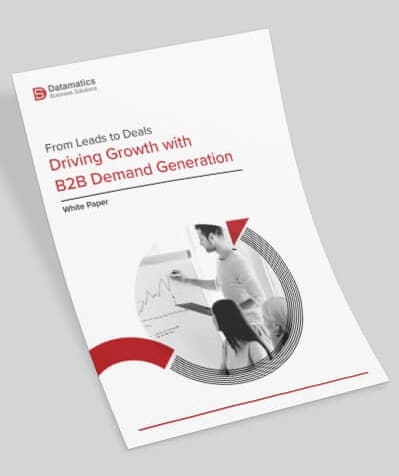According to Gartner, “By the end of 2022, over 70% of modern B2B marketers will use some form of third-party buyer intent data for prospect targeting or to engage with buyers in selected accounts.” Here’s why that number can further go up, and a compelling argument in favor of the rise of artificial intelligence in B2B demand generation.
Over the last decade or so, the use of terms like Artificial Intelligence (AI), Machine Learning (ML), and even Predictive Analytics has become more mainstream than ever before. Gone are the days when AI only seemed part of the golden age of arcade video gaming in the form of NPCs or corresponding levels of increasing difficulties. In current times, chances are you might have had an encounter with some of its applications, but you might not have noticed it. Such is the pervasive nature of these technological advancements. Without even knowing or feeling it, they have become a part of our everyday life. For the uninitiated, AI and ML are just computer programs to solve everyday problems like a human mind does. Apply that to any business scenario and you have a USD 169.4-billion-dollar industry by 2025 only. With AI, we are on the brink of reaching a new level of human civilization.
We have seen exponential technological advancement in the past decade or so in almost every industry. The world of marketing, too, isn’t untouched by it. The good ol’ days of maintaining a spreadsheet for appointment tracking, attending numerous meetings with one prospect in anticipation of a possible sale, and so on, are all passé. With the technological advancements, B2B marketing is becoming more and more data driven. Your engagement with a prospect begins even before any action occurs, thanks to technologies like AI. According to a recent study, a buyer spends around 50% of their time looking for useful information before taking any action. Apply AI on the right buyer intent data, and you will be able to prioritize your outreach while the buyer is still in the decision making or research stage. Here’s how –
AI-led prospect segmentation –
The audience pretty much decides the success or failure of a marketing campaign. B2B lead generation data providers run AI on the current buyer intent data and consider the buyers’ history while predicting the future course of action. It enables them to segment the prospects in a more granular and data-driven manner.
When the talks of being “data-driven” are widespread in the business fraternity, running a campaign without a properly segmented database is nothing short of shooting in the dark. Artificial intelligence carefully analyzes the data, creating a pool of potential prospects based on their digital presence, web footfalls, technological orientation, web mentions, purchase history, and more , capturing all essential information you need to boost your sales. Segmenting audience into specific groups for effective marketing campaigns and personalized user experience has been AI’s most effective and applauded uses.
Data-driven demand generation –
In the world where COVID-19 didn’t exist, B2B lead generation worked because people met people, they spoke, and, as they say, “sealed the deal.” Sadly, that world doesn’t exist anymore. Not to mention how time-consuming, expensive, and even draining that whole process was! Even before the pandemic, businesses had identified the underlying issue and were propelling for a more data-driven approach. The breakout of the COVID-19 just fueled that propulsion.
Enter: Artificial Intelligence. Over 27% of B2B buyers spend their buying process doing research online, leaving behind enough data points to be segmented into a potential prospect category. A team of expert data analysts spends a month analyzing that stream of data that floats on the web every day to generate real-time business insights. It allows businesses to use those insights in making an informed decision without weighing heftily on chasing one potential target, saving millions in revenue and staff hours.
AI-powered database –
It’s worth noticing that there’s a vast difference between a computer software-collected database and an AI-powered database. The naysayers might think otherwise, but both, technically and ethically, there’s a huge difference. The best a computer software-collected database can do is help you segment your audience by geography or some other concrete parameter. It has no means to identify a buying pattern, predictive analytics to determine the future course of action for a prospect, and neither can it narrow down your audience to the very minute segment like their social preferences.
With AI-powered data solutions, the possibility of narrow downing your database is virtually endless. Anything you can think of AI can drill down the database to that level. One fine example from the B2C world of how powerful is AI-driven marketing, is the Facebook Ad platform. It’s incredible to see the segmentation levels they offer for every single ad you want to run. Now, while that’s a social platform, there’s no denying that it cannot be achieved on a B2B database.
Your B2B demand generation needs disruption –
Disruption isn’t always bad, as we have seen on a plethora of technological fronts. The B2B demand generation for long has been longing for disruption, and the rise of AI, could very well be one. The world of lead generation is changing with the digital disruption in all walks of life. According to a recent report, businesses using artificial intelligence in some capacity can see their close rates for sales go up by 59%, up to 58% increase in revenue, 54% more engagement and traffic, and up to 52% higher conversion. Those are all staggering numbers to look at.
If you are looking to revamp your demand generation process to ramp up your sales and revenues, the answer lies in AI-powered B2B data solutions. It’s always good to have a solution that identifies verifiable potential gains and then deliver the leads to meet them. Should you need one, give us a shout out, and we will be there.
 Select an element to maximize. Press ESC to cancel.
Select an element to maximize. Press ESC to cancel. Select an element to maximize. Press ESC to cancel.
Select an element to maximize. Press ESC to cancel.Your B2B demand generation needs disruption
Disruption isn’t always bad, as we have seen on a plethora of technological fronts. The B2B demand generation for long has been longing for disruption, and the rise of AI, could very well be one. The world of lead generation is changing with the digital disruption in all walks of life. According to a recent report, businesses using artificial intelligence in some capacity can see their close rates for sales go up by 59%, up to 58% increase in revenue, 54% more engagement and traffic, and up to 52% higher conversion. Those are all staggering numbers to look at.
If you are looking to revamp your demand generation process to ramp up your sales and revenues, the answer lies in AI-powered B2B data solutions. It’s always good to have a solution that identifies verifiable potential gains and then deliver the leads to meet them. Should you need one, give us a shout out, and we will be there.
 Select an element to maximize. Press ESC to cancel.
Select an element to maximize. Press ESC to cancel. Select an element to maximize. Press ESC to cancel.
Select an element to maximize. Press ESC to cancel. Select an element to maximize. Press ESC to cancel.
Select an element to maximize. Press ESC to cancel. Select an element to maximize. Press ESC to cancel.
Select an element to maximize. Press ESC to cancel.
Hemant Jain


